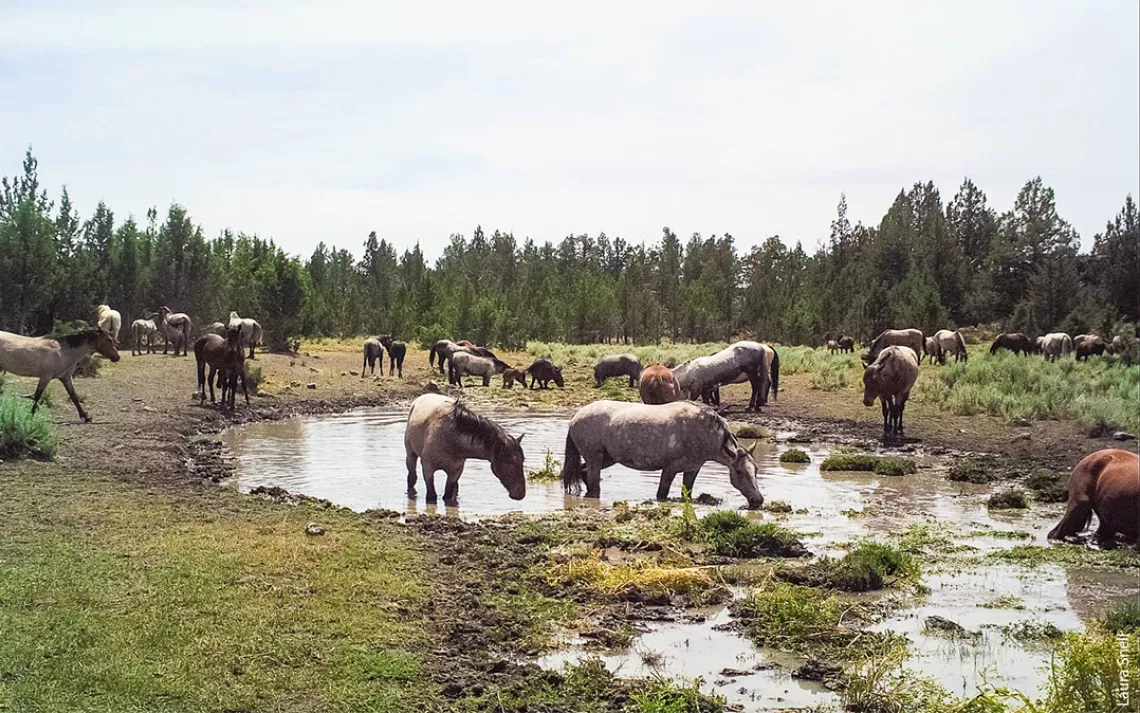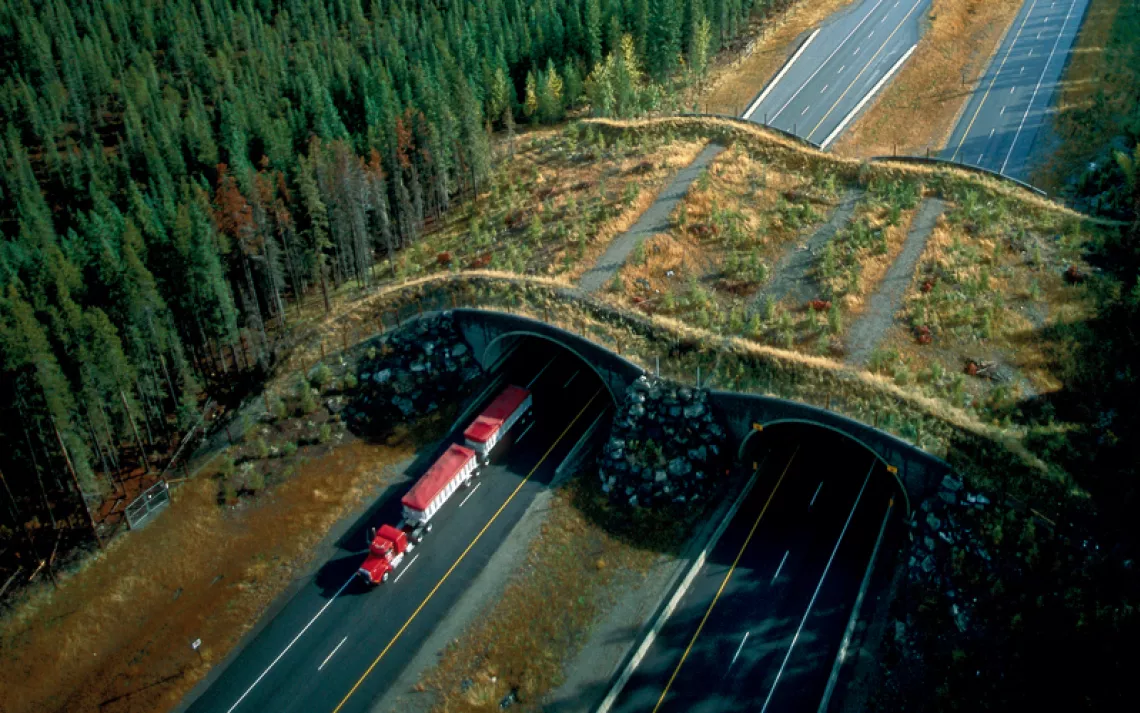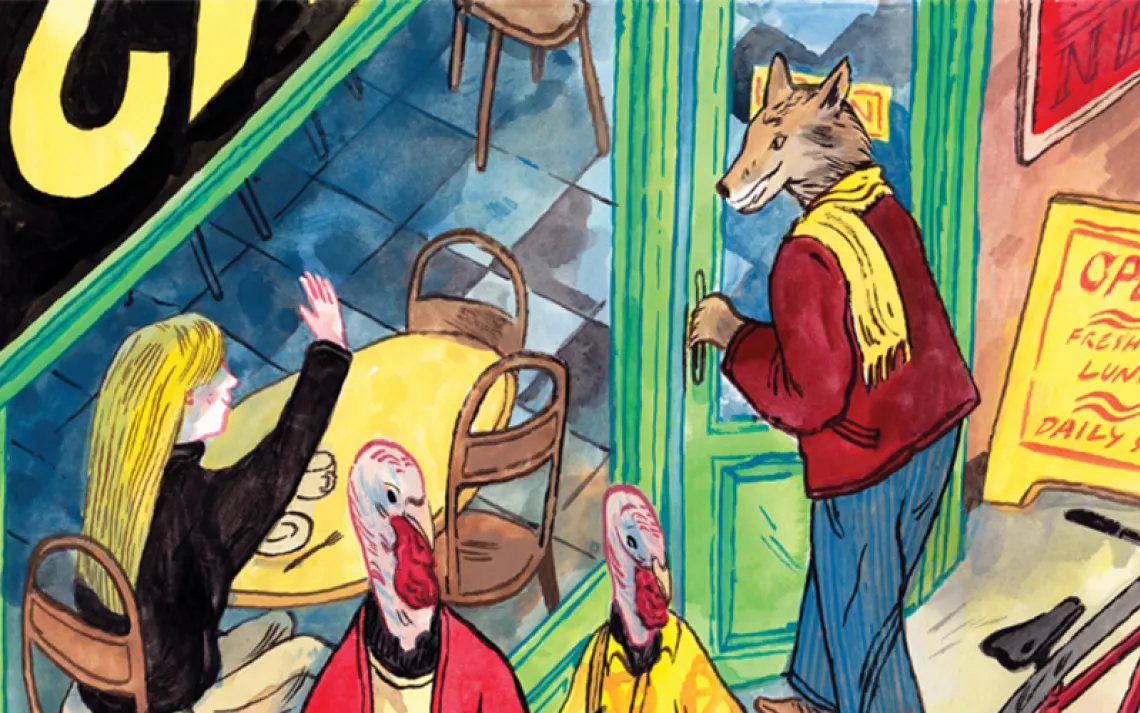Horses Gone Wild
A recent project shows that wild horses are inflicting ecological damage

Photo courtesy of Laura Snell
The Devil’s Garden covers about half a million acres of the Modoc Plateau—an area stretching across private ranches, tribal land, and a huge expanse of the Modoc National Forest in far northeastern California. The semiarid, volcanic landscape is studded with juniper and ponderosa pine, and is great grazing country for herds of wild horses. The horses are allotted 230,000 acres of public land, but recently that space has grown a bit too cozy. Though the U.S. Forest Service aims to keep the herd at 206 to 402 adults, in the last decade the population has mushroomed to over 2,240.
Those numbers are unprecedented, and the ecological impact largely unstudied. That’s why in 2015, Laura Snell, livestock and natural resources advisor for the University of California Cooperative Extension, and several colleagues began analyzing the impact of the horses on the landscape. Snell and her colleagues set up camera traps at 24 water sources in the wild horse management area in Modoc and Lassen Counties. The cameras were set to take three photos every 15 minutes and were also triggered by a motion detector. Over a two-week sample period, they recorded 100,000 images cataloging daily life at the watering holes. What they show is that the animals dominate. At one site, horses made up 71 percent of visitors, cattle were 19 percent, and the final 10 percent were wild animals, including pronghorn and hawks.
Snell and her team also monitored the damage to vegetation caused by the groups of horses—some of which numbered 75 animals—visiting the springs and creeks. Over the course of the year, they cataloged the species composition, stubble height of grasses, and the spread of annual invasive species. What they found was not encouraging. “All of these should be healthy riparian ecosystems with grasses to the edge of the streams,” says Snell. “But in some places, there’s bare ground 30 or 40 feet out from the water.”
The team conducted similar surveys in 2016 and is analyzing the data; they will continue the research through 2017 and beyond, if they can secure funding. In the meantime, Snell is sharing her preliminary findings with lawmakers and the public to raise awareness about problems with the increase in wild horse populations.
It’s not just the Devil’s Garden that has seen an equine influx. Wild horses across the American West now number 67,000, 2.5 times as many animals as the Bureau of Land Management, which handles the vast majority of the herds, has deemed sustainable. That doesn’t count the 46,000 wild horses currently in federal holding facilities at the cost of $50 million dollars per year, the lion's share of the $75 million allotted for the entire federal wild horse and burro program. The problem is, no one is quite sure what to do about it. While the ideal is to adopt them out, there are only a few thousand takers per year, leaving tens of thousands of horses in long-term public care. In September, the BLM’s National Wild Horse and Burro Advisory Board took the radical stance that 44,000 of the animals should be euthanized, though the bureau said they have no intention of following through.
How wild horses figure into the landscape is not entirely clear. Modern horses, Equus caballus, likely first evolved in North America 1.7 million years ago. The species spread across the Bering Land Bridge and became more established in Eurasia. But about 10,000 years ago, as the Pleistocene era came to a close, horses along with mammoth and sabre-toothed cats disappeared from the Americas. Researchers still aren’t sure why—disease, climate change, and even human hunting are all potential causes. Horses returned to North America with European settlers, and abandoned animals that were turned loose to graze eventually created feral herds that exist to this day.
In 1971, researchers believed those herds were diminishing and in need of protection. So Congress passed the Wild Free-Roaming Horses and Burros Act, which declared “wild free-roaming horses and burros are living symbols of the historic and pioneer spirit of the West; that they contribute to the diversity of life forms within the nation and enrich the lives of the American people.” It put the animals under the control of the Interior Department and made it illegal to capture, brand, harass, or kill them. Under those protections, the horses multiplied, reaching their current numbers.
The questions surrounding the horses are thorny. Are they a native or invasive species? Are they deserving of the special status they’ve been granted? And do they damage the environment, or do they still have a place in North American ecosystems?
That last question has gotten surprisingly little study. One reason is the aforementioned congressional act—researchers aren’t allowed to remove the horses from their range, so setting up comparative studies is difficult. The very few reports available show mixed impacts. According to a 2014 study in the journal ECOSPHERE, in semiarid environments, horses cause soil compaction, erosion, and reduced cover for other species. A 2009 study in the journal BMC Ecology showed that horses did compact soils along horse trails, but the disturbances they created and their feces increased plant diversity along the trail.
Snell says she hopes her research will add a little bit more information to the conversation, and hopes it will convince lawmakers to find a solution that will help the environment and the animals themselves. “Realistically, at this point, decisions about handling the horses have to be made at the highest levels. Politicians want to hear about the horses and want to see the pictures, too,” she says. “If we wait until the horses are dying and sick and really hungry, we’ve already lost the environment.”
Solutions, however, are hard to come by. Suzanne Roy, director of the American Wild Horse Campaign, which advocates for wild horse welfare, argues that the BLM should open up more federal land to the animals, which would even out any impact they may have. “The wild horses are only on a small percentage of public land. Eighty percent of forage is allocated to livestock, and we have a system where we give horses the scraps of forage out there then set allocation based on these limits,” says Roy. “Horses aren’t overpopulated, just greatly outnumbered by livestock on the land. We argue for a fairer share of resources for wild horses on public land.”
Roy, and many others, also advocate dosing mares with PZP, a new type of contraceptive to help keep the herd in check. But that drug is expensive and needs an annual booster shot to work effectively, making it a costly and long-term project. It also doesn’t protect the landscape from the horses. Snell thinks there is a more immediate solution, though she emphasizes that it’s her personal opinion and not that of the University of California. “The U.S. is the only country in the world that does not eat horses. I’ve traveled in Europe, Japan, Canada, and other places where they eat them. It’s even sought after by athletes,” she says. “Realistically, the idea that we as American people are so high on our first-world standards that we’re going to spend $50 million feeding horses on land we could use to feed other hungry people bothers me. I think we should take off all horses over five years of age from the long-term holding facilities.”
The American public probably doesn’t have the stomach for that, but at least in the Devil’s Garden, they are making incremental strides toward getting the horse population down. In September, the Forest Service rounded up about 200 horses for adoption, the first horses removed from the range in over a decade.
 The Magazine of The Sierra Club
The Magazine of The Sierra Club







